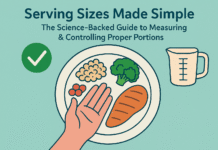You’ve seen them everywhere: slick calendars, daily prompts, and promises that a month from now you’ll feel like a different human. The 30-day workout challenge trend is more than a marketing hook—it’s a surprisingly effective way to kick-start real physiological change and lock in consistent habits. In the first 100 words (ahem, right now), we’ll unpack the science behind the 30-day workout challenge: what adaptations your body can actually make in four weeks, how the brain builds habits on that timeline, and how to design a safe, results-driven plan you can stick to. This deep-dive is for beginners through busy intermediates who want evidence over hype.
Disclaimer: This article provides general education, not medical advice. If you have a health condition, are pregnant, or are recovering from injury, consult a qualified professional for personalized guidance.
Key takeaways
- Thirty days is enough to jump-start measurable fitness gains (cardio capacity, strength skill, and consistency), but not enough for massive structural changes—set expectations accordingly.
- Early strength improvements are mostly neural; big muscle size and tendon changes take longer than four weeks.
- Short, structured intervals and progressive resistance work well in 30-day formats—if you plan recovery and avoid rapid jumps in load.
- Habits stick with cues, “if-then” plans, and visible streaks; 30 days is a natural behavioral runway for consistency.
- Track a few simple KPIs (resting heart rate, reps at a fixed weight, time to complete a set workout, daily minutes) and progress 2–10% when sessions feel easier.
- DOMS isn’t danger, but sharp or escalating pain is—use rest days, sleep, and gradual progression to reduce injury risk.
What a 30-Day Workout Challenge Actually Is (and Isn’t)
What it is & the core purpose
A 30-day challenge is a short, pre-planned sequence of workouts with daily (or near-daily) prompts. The goal isn’t to overhaul your physiology overnight. It’s to compress decision-making, reduce friction, and create enough exposure to training for your body and brain to adapt. In practice, you’ll aim for 4–6 training days per week with 2–3 lighter or recovery days.
Why it’s useful
- It eliminates choice overload. You know exactly what to do today.
- It creates a feedback loop. Frequent sessions give you quick wins (better technique, faster times, extra reps).
- It builds confidence and identity. Four weeks of receipts (“I show up”) is powerful.
Requirements & low-cost alternatives
- Space: 2×2 meters is plenty.
- Gear: None required. Optional: a mat, a pair of dumbbells or resistance bands, a chair/bench, and a timer app.
- Low-cost swaps: Books/backpack as weights, stairs for step-ups, towel for isometrics.
Step-by-step for beginners
- Pick your pillars: one cardio modality (walking, cycling, intervals) + one strength pattern per day (push, pull, hinge, squat, core).
- Schedule your week: 3 strength days + 2 cardio days + 1 mixed day + 1 full rest day.
- Lock your cue: same time of day, same place, same pre-workout ritual (fill water, set timer, play the same playlist).
Beginner modifications & progressions
- Modify range (elevated push-ups, partial squats) → full range → load.
- Start with work:rest 20:40 for intervals → progress to 30:30 or 40:20.
- Keep reps in reserve (RIR): stop with 1–3 reps “in the tank,” then reduce RIR over the month.
Frequency, duration, metrics
- Frequency: 4–6 days/week.
- Duration: 20–45 minutes/session.
- Metrics: minutes of activity; reps at a fixed load; time to complete a fixed circuit.
Safety, caveats, common mistakes
- Mistake: Daily max-effort sessions. Fix: alternate hard/easy days.
- Mistake: Random YouTube roulette. Fix: follow one plan for four weeks.
- Mistake: Skipping warm-ups and loading too fast. Fix: short dynamic warm-up and modest weekly progress.
Mini-plan example (2–3 steps)
- Mon: 30 minutes brisk walk + 2×12 bodyweight squats, 2×20-sec plank.
- Wed: 8×20-sec fast/40-sec easy intervals (bike or jog) + 2×10 elevated push-ups.
- Fri: 3 rounds: 10 hip hinges, 10 rows (bands), 20-sec side plank/side.
What Changes Can Realistically Happen in 30 Days?
Cardiovascular system: “engine” upgrades come fast
In the first 2–4 weeks, interval and steady-state training can improve aerobic capacity and cellular machinery (mitochondrial function) that powers endurance. Short-term interval formats (even low volume) have been shown to boost VO₂max and oxidative capacity in as little as two to four weeks. These are internal changes—your scale might not budge, but your workouts feel “easier.”
Muscular system: strength skill first, size later
Early strength gains are driven largely by neural adaptations—better motor unit recruitment, coordination, and technique—while visible hypertrophy tends to lag and becomes more detectable with longer training (often beyond 6–8+ weeks, depending on method and measures). You’ll feel stronger within weeks, even if the mirror looks the same.
Connective tissue: the slow adapter
Tendons stiffen and strengthen with training, but their most reliable changes usually require 8–12+ weeks of appropriate loading. This matters: if you ramp muscle strength fast but the tendon hasn’t caught up, you increase strain and overuse risk. Translation: month one should be progressive, not explosive.
Recovery biology you’ll notice
- DOMS (delayed-onset muscle soreness) typically peaks 24–72 hours after new or hard sessions and then fades within days.
- Muscle protein synthesis is elevated after lifting for roughly 24–36 hours—another reason not to blitz the same muscle daily.
What to track in 30 days
- Resting heart rate (RHR): Often trends a few beats lower with regular training.
- Repeatable test piece: e.g., time to complete the same 10-minute circuit, or how many push-ups in 60 seconds.
- Perceived exertion: Does the same pace feel easier? Good sign.
Mini-plan example
- Week 1 test: 1-mile walk/jog time + max push-ups in 60s.
- Week 3 re-test: Same tests; aim for small improvements.
- Week 4: Add a second, optional easy aerobic session to consolidate gains.
The Behavior Science That Makes 30 Days Stick
Why 30 days works psychologically
- Implementation intentions (“if-then” plans): Pre-deciding when/where/how you’ll train dramatically increases follow-through.
- Goal setting: Clear, challenging, specific goals outperform vague intentions (“work out more”).
- Habit formation curve: Automaticity generally increases with consistent repetition; 30 days is a solid runway to make your workout cue-response loop feel natural—even if full “automaticity” often takes longer.
- Commitment devices & streaks: Visible streaks, public commitments, or small stakes keep you honest.
Requirements
- Calendar app or printed calendar; a visible checklist; a 5-minute nightly review.
Step-by-step
- Write an if-then plan: “If it’s 7:00 a.m., then I put on shoes and start my warm-up.”
- Make it visible: Put your monthly grid on the fridge; star every completed day.
- Pre-commit: Tell a friend; book a time on your calendar.
- Bundle temptation: Pair workouts with a favorite podcast or playlist you only play while training.
Beginner modifications
- Anchor to a tiny starter: “If it’s 6:30 p.m., then I do 5 minutes.” Momentum beats nothing.
- Use two acceptable time slots per day (morning or lunch) to protect the streak against schedule chaos.
Frequency/duration/metrics
- Consistency score: percent of planned days completed.
- Adherence triggers: note what worked (time/place) and what derailed you.
Safety/caveats/mistakes
- Don’t equate a missed day with failure. Make a “never miss twice” pact and move on.
Mini-plan example
- Cue: “After coffee, I set a 30-minute timer.”
- If busy: “If mornings blow up, I’ll walk 20 minutes after dinner.”
- Reward: Check off the box and snap a quick “done” photo to your accountability buddy.
Designing a Safe, Effective 30-Day Challenge (A Practical Framework)
Purpose
Create a month that respects recovery, progresses intelligently, and aligns with broad health guidelines.
Requirements
- A simple template with three levers: intensity, volume, and frequency.
- Tools: a timer, notebook/app, and optional bands/dumbbells.
Beginner-friendly weekly template
- Mon (Strength—Lower): Squat pattern + hinge pattern + core.
- Tue (Cardio—Intervals): Short bouts, long rests (e.g., 8×30 sec hard / 60 sec easy).
- Wed (Strength—Upper): Push, pull, carry/anti-rotation.
- Thu (Cardio—Steady): 25–40 minutes easy-moderate.
- Fri (Strength—Total): Unilateral lower + push + pull + core.
- Sat (Optional Mixed/Skills): Light technique circuit, mobility, or hike.
- Sun (Rest): Walk, stretch, nap.
Progression rules you can trust
- Only one variable at a time: slightly more load or reps or intervals—not all at once.
- Load bumps of ~2–10% when you can exceed the target reps/tempo with solid form.
- Keep 1–3 reps in reserve on most sets; push closer to “hard” only on the final set of a movement.
How hard should it feel?
- Hard days: breathing challenged, legs or lungs “burny,” but recover between efforts.
- Easy days: conversational pace; you should finish feeling better than you started.
Why rest matters
Training the same muscle group hard on back-to-back days is asking for cranky joints and stalled progress. Spacing hard lifts for a muscle by roughly 48 hours is a time-tested way to recover skills and strength while limiting overuse.
Safety, caveats, common mistakes
- Skipping warm-ups (don’t), maxing daily (don’t), adding too much jump volume too soon (also don’t).
- Hydration: noticeable dehydration (around 2% body mass loss) can impair performance; sip before you feel parched, especially in heat.
- Sleep: adults generally do best with ≥7 hours; it’s recovery rocket fuel.
Mini-plan example
- Strength day: 3 rounds: 8 goblet squats, 10 hip hinges, 8 rows/arm, 20-sec hollow hold.
- Intervals: 10×30 sec brisk uphill walk / 60 sec easy down; cool-down 5–8 minutes.
- Steady day: 30–40 minutes comfortable pace; you can talk in short sentences.
A Quick-Start Warm-Up (5–8 Minutes) and Cool-Down
Warm-up (do this before every session)
- Activation & mobility (2 min): Cat-cows, world’s greatest stretch, ankle rocks.
- Pattern primers (2–3 min): Bodyweight squats ×10, band pull-aparts ×15, hip hinge drill ×10.
- Potentiation (1–3 min): Two short pick-ups (10–15 sec brisk walk/jog or fast cycle spin), 45–60 sec easy between.
Cool-down (3–5 minutes)
- Easy walk or gentle cycling until breathing normalizes.
- Light mobility (hip flexors, calves, thoracic rotations).
- Log how it felt.
Measuring Progress (So You Actually See Results)
Pick 3–4 KPIs—not 14.
- Consistency: % of planned days completed.
- Capacity: time to complete a standard circuit, or intervals accomplished at the same pace.
- Strength skill: reps completed at a fixed weight (or a harder leverage version).
- Recovery: morning resting heart rate trend; general energy and sleep hours.
- Subjective: “Talk test” ease, session RPE, how joints feel the morning after.
Easy test options
- Push-up test (60 seconds).
- Sit-to-stand test (30 seconds).
- 10-minute AMRAP (as many rounds as possible) of 5 squats, 5 push-ups (elevated if needed), 10 step-backs.
How to use numbers
- If a KPI stalls for a week: nudge one variable (add one set, or +5–10% load, or +1–2 intervals).
- If you feel worn down: cut volume by 20–30% for 3–4 days and sleep more.
Troubleshooting: Common Pitfalls (and Simple Fixes)
“I’m too sore to move.”
That’s DOMS, which typically peaks 24–72 hours after unfamiliar work. Keep moving lightly, rotate muscle groups, and add an active recovery day. If pain is sharp, localized, or worsens session to session, back off and evaluate.
“My knees/back feel cranky.”
Check form, reduce depth or range, switch to split-stance or supported variations, and lower load by 10–20% for a week while you groove technique.
“I missed two days.”
Resume where you left off. Don’t “make up” missed volume with a marathon session.
“Intervals make me dread training.”
Swap one interval day for a steady 30–40 minutes at conversational pace. Consistency beats perfection.
“No time.”
Do 15-minute “minimum effective” blocks: 5-minute warm-up + 8 minutes of EMOM (every minute on the minute) alternating squats and rows + 2-minute cool-down.
“Progress stalled.”
Progress one variable: add a set, small load bump, or one additional interval; keep rest the same for a week.
“Sleep is a mess.”
Protect a wind-down: dim lights 60 minutes pre-bed, consistent schedule, cool room. Better sleep amplifies your month-long gains.
A Simple 4-Week Starter Plan (Roadmap)
Who it’s for: Beginners to busy returners. Adjust reps/loads to keep 1–3 reps in reserve most sets.
Weekly rhythm (repeat with small progressions each week):
- Mon—Lower strength (30–40 min):
- Warm-up → 3 sets: Goblet squat 8–10, hip hinge 10–12, split squat 8/side, plank 20–30s.
- Progression: +1–2 reps or small load bump week to week.
- Tue—Intervals (20–30 min):
- 8–10× 30 sec fast / 60 sec easy (walk, bike, row).
- Progression: add 1 interval each week or make 30:45 in week 4.
- Wed—Upper strength (30–40 min):
- 3 sets: Elevated push-ups 8–12, rows 10–12/side, overhead press (light dumbbells) 8–10, side plank 15–25s/side.
- Progression: elevate lower (harder push-ups) or add small load.
- Thu—Steady cardio (25–40 min):
- Comfortable pace. You finish energized.
- Progression: +5 minutes each week.
- Fri—Total-body strength (30–40 min):
- 3 sets circuit: Step-ups 10/side, hip hinge 10–12, floor press 8–10, band pull-Apart 15–20, carry 30–40 meters.
- Progression: +1 set by week 3 or small load bump.
- Sat—Optional mixed / mobility (20–30 min):
- Light technique work, longer mobility, or an easy hike.
- Progression: keep easy; this is for feeling good.
- Sun—Rest
Week-by-week checkpoints
- End of Week 1: Note soreness patterns; adjust exercise order to protect grumpy joints.
- End of Week 2: Re-test one KPI (push-ups in 60s, or your 10-minute circuit rounds).
- End of Week 3: Small load or volume bump on primary lifts (+2–10%).
- End of Week 4: Re-test KPIs and write “What worked / What to keep / What to change.”
Fuel, fluids, and sleep (simple rules)
- Include a protein-rich meal within a few hours after lifting.
- Drink regularly across the day; more in heat or long sessions.
- Aim for ≥7 hours of sleep with a consistent schedule.
FAQs
1) Can I really get results in 30 days?
Yes—expect improvements in cardio capacity, strength skill, and consistency. Visible muscle size and connective-tissue remodeling usually need longer than a month.
2) How often should I work out?
Aim for 4–6 days per week with at least one full rest day. Separate hard strength sessions for the same muscle group by roughly 48 hours.
3) Are intervals safe for beginners?
Yes, if you start conservatively (e.g., 20–30 sec hard / 40–60 sec easy) and keep total work modest. Progress gradually and stop a set if your form degrades.
4) I’m very sore—should I train?
Light movement is fine during typical 24–72-hour DOMS. If pain is sharp, localized, or worsening, rest and reassess your progressions.
5) What should I track?
Pick 3–4 KPIs: resting heart rate, reps at a fixed load, time to complete a standard circuit, and consistency. Re-test every 1–2 weeks.
6) Do I need equipment?
No. Bodyweight plus bands can carry you a long way. If you have dumbbells, great—add gentle load bumps (~2–10%) when sets feel too easy.
7) Is it okay to double up workouts if I miss a day?
Generally, no. Resume your plan and extend the challenge by a day if you want—quality > cramming.
8) How long should my workouts be?
20–45 minutes is plenty for a month-long consistency push. If time-crunched, do 15 minutes: warm-up, two movements, cool-down.
9) How much should I push weights?
Maintain 1–3 reps in reserve most sets. Increase load slightly when you exceed the target reps with excellent form.
10) What if my knees or back complain?
Reduce range, switch to supported variations, lower load by 10–20%, and emphasize technique. If symptoms persist, consult a professional.
11) Will better sleep really improve results?
Yes. Adults generally benefit from ≥7 hours per night; it supports recovery, performance, and adherence.
12) Can I keep the streak after 30 days?
Absolutely. Use your notes to design a simple next block: same template, slightly heavier, or a new goal (e.g., 5K run, push-up milestone).
Conclusion
Thirty days is the perfect on-ramp: enough time for your heart, brain, and movement patterns to meaningfully adapt, and short enough to feel doable. Plan smart progressions, insist on consistency over heroics, and let the calendar do the motivational heavy lifting. Next month, you won’t be starting over—you’ll be starting ahead.
CTA: Pick your start date, print a 30-day grid, and write your first “if-then” plan—then set a timer and begin your warm-up today.
References
- WHO guidelines on physical activity and sedentary behaviour. World Health Organization. Published November 25, 2020. https://www.who.int/publications/i/item/9789240015128
- WHO guidelines on physical activity and sedentary behaviour (Full PDF). World Health Organization. 2020. https://iris.who.int/bitstream/handle/10665/336656/9789240015128-eng.pdf
- Physical activity: fact sheet. World Health Organization. Updated June 26, 2024. https://www.who.int/news-room/fact-sheets/detail/physical-activity
- VO₂max Trainability and High Intensity Interval Training in Humans: A Meta-Analysis. PLOS ONE. Published September 16, 2013. https://journals.plos.org/plosone/article
- Effects of different protocols of high intensity interval training for VO₂max improvements in adults: A meta-analysis of randomised controlled trials. PubMed record. 2019. https://pubmed.ncbi.nlm.nih.gov/30733142/
- Metabolic adaptations to short-term high-intensity interval training: a little pain for a lot of gain? PubMed record. 2008. https://pubmed.ncbi.nlm.nih.gov/18362686/
- Short-term sprint interval versus traditional endurance training: similar initial adaptations in human skeletal muscle and exercise performance. The Journal of Physiology (abstract). 2006. https://physoc.onlinelibrary.wiley.com/doi/abs/10.1113/jphysiol.2006.112094
- Adaptations to Endurance and Strength Training. Frontiers in Physiology. 2018. https://pmc.ncbi.nlm.nih.gov/articles/PMC5983157/





































